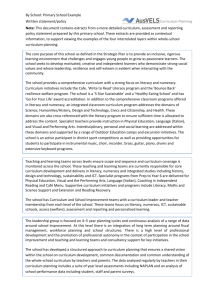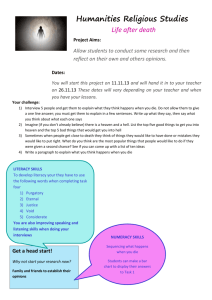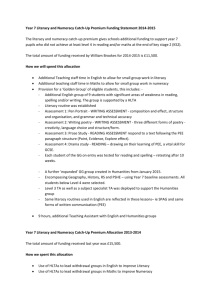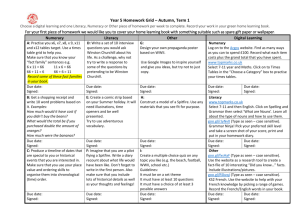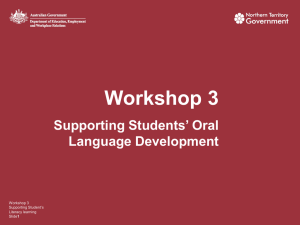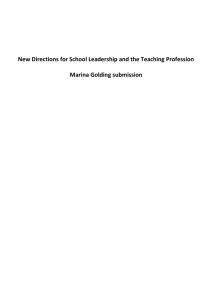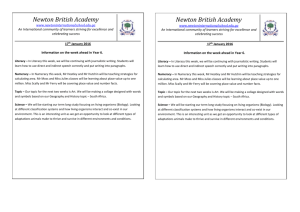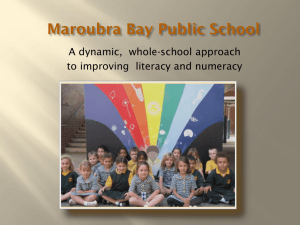Literacy and Numeracy Pilot in low SES school communities
advertisement
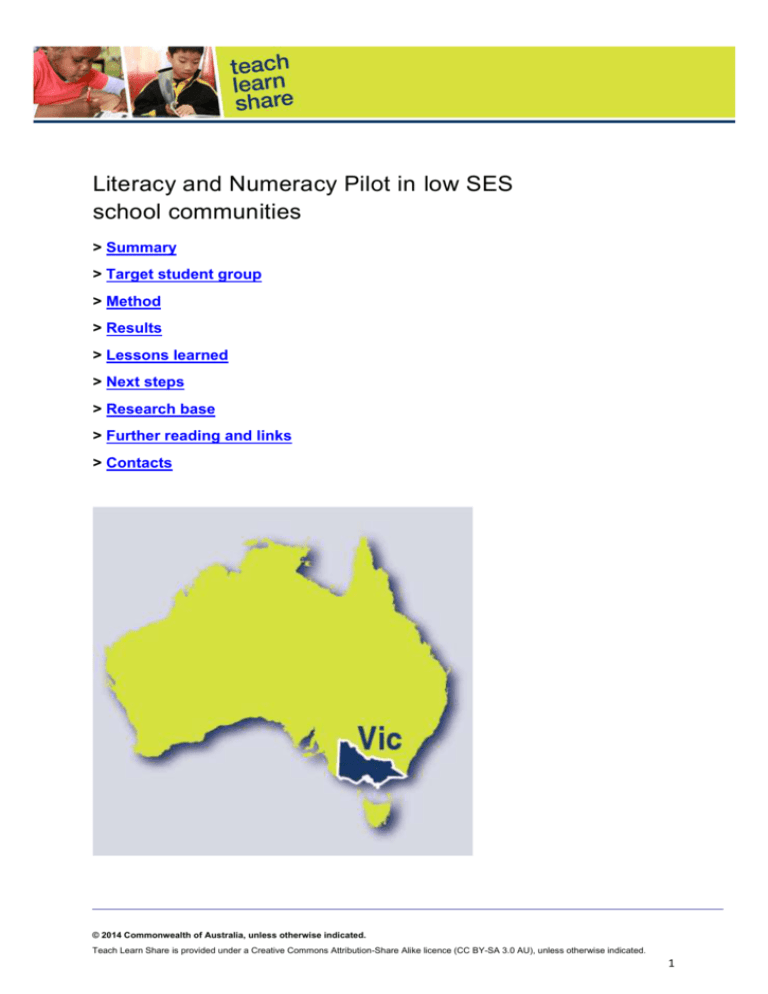
Literacy and Numeracy Pilot in low SES school communities > Summary > Target student group > Method > Results > Lessons learned > Next steps > Research base > Further reading and links > Contacts © 2014 Commonwealth of Australia, unless otherwise indicated. Teach Learn Share is provided under a Creative Commons Attribution-Share Alike licence (CC BY-SA 3.0 AU), unless otherwise indicated. 1 Summary This report describes the Australian Government Department of Education, Employment and Workplace Relations (DEEWR) Literacy and Numeracy Pilot in low socio-economic status school communities in 2009 and 2010. The pilot adopted a strategic, multifaceted approach to sustainable improvement in literacy and numeracy outcomes for all students in primary and secondary schools. The aim was to create new and improved practices in schools by implementing a range of approaches, based on local analysis of need. Planning and sharing occurred at both the school and cluster levels, using accountability and improvement frameworks. The pilot focused on five areas of reform: leadership capacity to adopt whole-school approaches and to work effectively across school clusters; teacher capacity to improve practice in teaching literacy and numeracy; data-driven approaches to targeted learning; student centred approaches; and community engagement. Four clusters were selected: two in a rural region (Hume) and two in a metropolitan region (Western). The clusters were chosen because their student populations met the target groups for the pilot: low socio-economic status (low SES), Koorie, English as an additional language (EAL), and student recently arrived in Australia. The pilot was financed by a co-contribution model involving funding from the Department of Education, Employment and Workplace Relations (DEEWR) and schools. Schools also used recurrent funding through the Student Resource Package. Schools with Koorie students who were not achieving at expected achievement standards in one or more dimensions of the English or mathematics domains of the Victorian Essential Learning Standards (VELS) were also supported through the Wannik Tutorial Program. The following reports only on the involvement of primary schools in the pilot. However, the approaches were also found to be useful in secondary schools. Target student group The focus for intervention was on students from low SES school communities, new arrivals, refugees, Koorie students, and students with English as an additional language (EAL) from Foundation to year 10. The students' literacy and numeracy learning was identified as at or below the National Minimum Standard, based on NAPLAN results. The pilot involved students and teachers from 36 primary schools in two rural and regional clusters. Two P–12 colleges and 26 primary schools from two metropolitan clusters participated. There were also 12 secondary schools involved in the pilot. © 2014 Commonwealth of Australia, unless otherwise indicated. Teach Learn Share is provided under a Creative Commons Attribution-Share Alike licence (CC BY-SA 3.0 AU), unless otherwise indicated. 2 Method The aim of this pilot was to trial a cluster-wide implementation of a multifaceted approach to literacy and numeracy improvement. The pilot built on strategies already implemented in both regions. The Effective Schools Model (1995) was operating at the time of the pilot, and provided the systemic context. A number of elements of the Effective Schools Model – such as professional leadership, purposeful teaching and a focus on teaching and learning – were key elements of the pilot. The multifaceted approach encouraged whole-school commitment from all cluster schools. It employed strategies including school-based and regional coaches of literacy and numeracy; regional literacy and numeracy coordinators; and the provision of extensive professional learning opportunities for school leaders, teachers, and school-based staff to support student intervention in literacy and numeracy. Students' data were analysed to inform planning for differentiated teaching and learning. Professional learning teams were developed to support teachers, schools and clusters. A model of shared responsibility for achieving improved literacy and numeracy outcomes for all students across the cluster was developed using Strategic and Annual Implementation Plans, or cluster plans. This involved collecting agreed data at agreed times to monitor students' progress, and using students' data to inform decisions about the allocation of resources at the school level, including the use of school-based literacy and numeracy coordinators. Data-driven initiatives were based on the collection of a range of information, such as anecdotal records, assessment and running records. Literacy and numeracy coaches were appointed, and a strong evaluation and research framework was developed for a proposal that informed the work of participating schools to build knowledge of what works for literacy and numeracy intervention. Teachers engaged in professional learning opportunities at the school and cluster level, and built their capacity to accurately assess student learning and deliver quality classroom instruction in literacy and numeracy to support all students to make progress. Based on data analysis, teachers engaged in informed planning, determined levels of student need, identified student learning trajectories, planned groups of students for targeted instruction, and designed differentiated learning tasks and activities to meet learning needs. Literacy and numeracy student intervention programs were developed and implemented. Published examples include the: Wannik Tutorial Program Reading Recovery Guidelines Hume Region Numeracy Strategy at Seymour College . © 2014 Commonwealth of Australia, unless otherwise indicated. Teach Learn Share is provided under a Creative Commons Attribution-Share Alike licence (CC BY-SA 3.0 AU), unless otherwise indicated. 3 The professional learning teams provided a necessary forum for professional discussion, reading and reflection, increased collaboration and collegiality. The teams were central to establishing consistent approaches to teaching and learning in classrooms. Through professional learning teams, teachers developed a common language for inquiring into teaching and learning, and shared student data to develop curriculum and inform planning for teaching. Time was provided in school timetables for meetings and professional learning. Teachers placed high value on shared spaces and places for professional conversations. Results Results demonstrated improvement of literacy and numeracy learning in primary schools to a moderate extent. Table 1 shows assessment tools and times of assessment. Table 1: Assessment tools and times of assessment Year level F–2 Online assessment tools English Online Interview Time of assessment March 2009–September 2009 March 2010–September 2010 F–2 Mathematics Online Interview March 2009–September 2009 March 2010–September 2010 3–6 Victorian Curriculum and Assessment Authority (VCAA) On Demand Adaptive Tests for Reading and Number March 2009–September 2009 3, 5, 7 NAPLAN – reading, writing, spelling, grammar, punctuation 2008 5, 7 NAPLAN – reading, writing, spelling, grammar, punctuation 2010 3, 5, 7 NAPLAN – numeracy 2008 5, 7 NAPLAN – numeracy 2010 F–6 Teacher judgement for English and mathematics for reporting periods Semesters 1 and 2, 2008 March 2010–September 2010 Semesters 1 and 2, 2009 Semester 1 in 2010 The overall improvement in literacy and numeracy achievement was evident in NAPLAN data. Improved outcomes in reading and number for students in years 3–6 were sustained over the two years of the pilot and were consistent across NAPLAN, VCAA On Demand Assessment and VELS Teacher Judgements. © 2014 Commonwealth of Australia, unless otherwise indicated. Teach Learn Share is provided under a Creative Commons Attribution-Share Alike licence (CC BY-SA 3.0 AU), unless otherwise indicated. 4 Table 2 shows the overall comparative mean growth in the NAPLAN assessments from 2008 to 2010 for the pilot schools and all Victorian students for years 3–5. Table 2: Overall comparative mean growth in NAPLAN assessments 2008–2010 for pilot schools and all Victorian students in years 3–5 Year level NAPLAN Domain Pilot schools Pilot schools Victorian schools Student number Average growth Average growth Year 3–5 Reading 1809 88.29 82.3 Years 3–5 Writing 1807 75.6 70.2 Years 3–5 Spelling 1815 84.33 77.9 Years 3–5 Grammar and punctuation 1815 87.59 83.5 Years 3–5 Numeracy 1802 91.49 85.5 The outcomes of particular cohorts of students – for example, EAL students, students newly arrived in Australia, and Koorie students – were positive. Primary Koorie student achievement improved, as outlined in Table 3. Growth was often at (or slightly below) expected levels. Table 3: Koorie primary student achievement in pilot schools compared to Koorie student cohorts across Victoria Learning focus Assessment instrument Primary Koorie student achievement in pilot schools compared to Koorie student cohorts across Victoria Number NAPLAN Significant impact on number achievement. Literacy domains NAPLAN Growth in learning in the pilot schools was similar to that of all Koorie students. Reading VCAA On Demand Growth in reading achievement was significantly greater than expected for the first six months of the pilot, and growth in number achievement was significantly greater than expected for the last six months of the pilot. © 2014 Commonwealth of Australia, unless otherwise indicated. Teach Learn Share is provided under a Creative Commons Attribution-Share Alike licence (CC BY-SA 3.0 AU), unless otherwise indicated. 5 EAL and refugee primary student results on average exceeded expectations, and growth in achievement was sustained, as outlined in Table 4. Table 4: Results of EAL and refugee primary school students Learning area Assessment instrument EAL and new arrival cohorts compared to primary school students across Victoria Reading and numeracy NAPLAN Growth was significantly greater than the expected rate of growth for both cohorts of students during Terms 2 and 3 in 2009 and 2010. Number VCAA On Demand data The gap in number achievement closed significantly between primary refugee and ESL students, and between primary non-refugee and non-EAL students during the period of the pilot. In the first year of the pilot, a process evaluation was conducted using both quantitative and qualitative approaches. In the second year of the pilot, an outcome evaluation involved in-depth case studies. Nine schools were chosen to showcase their significant growth in VELS literacy and numeracy achievement. The evaluation from this pilot highlighted that improved literacy and numeracy outcomes are best achieved by schools employing interventions adapted to their context. Lessons learned The cluster approach to improvement in literacy and numeracy provided structure and support for building leadership capacity, and aided the implementation of central and regional curriculum programs and initiatives. Through the pilot, teachers learnt to focus on different aspects of students' progress; monitor and track students' achievements over their school life; gain a clearer – or more complex – picture of students' achievement; triangulate results using different assessment instruments; and create a whole-class learning profile. Based on data analysis, teachers were informed when engaging in planning, grouping students, determining levels of need, and designing differentiated learning tasks and activities. They implemented ongoing monitoring (tracking) of individual student's achievement in literacy and numeracy, and identified, trialled and evaluated interventions (one-to-one or in small groups) for particular students. © 2014 Commonwealth of Australia, unless otherwise indicated. Teach Learn Share is provided under a Creative Commons Attribution-Share Alike licence (CC BY-SA 3.0 AU), unless otherwise indicated. 6 The pilot supported an increased emphasis on student-centered approaches. The most effective teaching approaches were those conducted daily with small groups of students in classrooms. Teachers encouraged students to take control of their learning, to see the relevance of their learning, and to make choices. In response to higher expectations, students generally held the belief that they could succeed. Professional learning teams of teachers, often between neighbouring schools, provided multiple opportunities to build leader capacity. At all levels of cluster collaboration, teachers and leaders shared resources, assessment data and practices. The cluster approach to build teacher capacity through quality professional learning activities and support by coaches and consultants was strategic to improvements. Leaders facilitated reflection, introduced new ideas and practices, and provided challenges and support for teachers. An increased culture of collaboration and collegiality was established and maintained. Principals commented that schools sharing expertise and resources across clusters was widespread. Next steps New initiatives should ensure that the school community understands and is committed to the five areas of reform: leadership and whole-school approaches; building teacher capacity; effective use of student data; student-centred approaches and interventions; use of broader community and parental engagement strategies. The multifaceted approach is considered essential to improving literacy and numeracy learning. Schools need to prepare for a multifaceted approach to improving student achievement in literacy and numeracy. This means building on existing strategies that are working and introducing a range of new strategies, including a strong commitment from the school and cluster leadership. Dedicated time and space should be provided for professional learning teams, using student data as the basis for focused teacher dialogue. Schools should establish prior agreement on key elements of approaches, such as classroom observations for all teachers; a strong commitment to the use of student data to inform planning for student-centred teaching of literacy and numeracy; the development and effective use of individual learning plans for students; and embedded strategies for the systematic collection of data, and the analysis and interrogation of this data. Trained literacy and numeracy leaders or coaches need to be appointed to provide expert support to teachers. © 2014 Commonwealth of Australia, unless otherwise indicated. Teach Learn Share is provided under a Creative Commons Attribution-Share Alike licence (CC BY-SA 3.0 AU), unless otherwise indicated. 7 Sustainability of the project can be formalised using cluster strategic plans and a school accountability and improvement framework. General strategies to ensure sustainability include developing criteria for quality implementation of comprehensive, multifaceted literacy and numeracy intervention programs; building cluster leaders' and principals' capacity to take ongoing responsibility for the sustainability and viability of the project; expanding and maintaining literacy and numeracy leaders' and teachers' literacy and numeracy knowledge to improve and sustain student learning outcomes; maintaining ongoing professional learning at the school, cluster and regional levels; refining the use of data to inform the next stages of teaching and learning; and embedding coaches as an internally funded, school-based resource in schools. Research base Victoria's systemic approach to school improvement is well documented. The effectiveness of this approach is confirmed by Organisation for Economic Cooperation and Development (OECD) and international experts. The Victorian Department of Education and Early Childhood Development (DEECD) adopted the Effective Schools Model (adapted from Sammons, Hillman & Mortimore, 1995), defining eight characteristics with evidence-based correlation to improved student learning outcomes. This framework shows that improving student learning requires a multifaceted approach. Essential components are professional leadership, purposeful teaching, and a focus on teaching and learning. The multifaceted approach has a strong cluster focus, encouraging whole-school commitment from all schools in a cluster. Evidence shows that clustered learning communities produce greater outcomes than schools operating alone. Such clusters of schools create communities of innovation, enquiry and transfer that are meaningful and relevant to the context and the community within which the problems must be solved and practice improved. Bringing together practical and theoretical knowledge has been shown to promote advanced teaching practice (Desforges, 2005). Through research, seven principles were identified that outline the key characteristics of highly effective professional learning, and provide a common language for describing good practice. Professional Learning in Effective Schools (Department of Education & Training, 2005) aligns these seven principles and describes the culture and conditions necessary to implement an effective professional development program. © 2014 Commonwealth of Australia, unless otherwise indicated. Teach Learn Share is provided under a Creative Commons Attribution-Share Alike licence (CC BY-SA 3.0 AU), unless otherwise indicated. 8 Victoria's Early Numeracy Research Project (1999–2001) and Middle Years Numeracy Research Project (1999–2000) found that a whole-school approach to numeracy improvement, supported by effective leadership, was the key to achieving success. They provided evidence-based recommendations about school organisation and supporting structures that lead to improved student learning outcomes in mathematics. Victoria's Early Years Literacy Research Project (1996–1998) and Successful Literacy Interventions Literacy Research Project (2001) indicated that substantial improvements in student early literacy outcomes (effect size 0.65) and literacy outcomes for students in Year 7 – demonstrated on pre- and post-qualitative and quantitative data measures – can be achieved when schools adopt a whole-school approach such as the Effective Schools Model. Factors contributing to improved student learning outcomes in literacy included professional learning for teachers, supportive leadership, and establishing effective links between home and school. The Middle Years Literacy Research Project (2001) and Restart (2004) support these findings. The Department's Literacy Improvement Team Initiative (2007–2011) and Teaching and Learning Coaches Initiative (2008–2011) provided coaches to build teachers' capacity to improve the mathematics or literacy of students in years P–10, with a focus on Koorie students. Evidence from the coaching initiatives showed their positive impact on teacher and school leadership capacity, and demonstrated improved student outcomes. Further reading and links Desforges, C 2005, On learning and teaching, National College for School leadership, accessed on 9 April 2013, www.crescentok.com/staff/jaskew/isr/L2L/L2L2.pdf Rowe, KJ & Meiers, M 2005, Restart: Evaluation of the Restart Initiative in Victorian Government secondary schools 2002–2004. A research and evaluation report to the Targeted Initiatives Unit, Student Learning Division, Department of Education and Training, Victoria, ACER, Camberwell, Victoria. Sammons, Hillman & Mortimore 1995, Key Characteristics of Effective Schools: A Review of School Effectiveness Research, Office for Standards in Education (OFSTED), London. Victorian Department of Education and Early Childhood Development (DEECD) 20102012, Digital Stories, www.education.vic.gov.au/school/teachers/support/Pages/forumdigi.aspx © 2014 Commonwealth of Australia, unless otherwise indicated. Teach Learn Share is provided under a Creative Commons Attribution-Share Alike licence (CC BY-SA 3.0 AU), unless otherwise indicated. 9 The Digital Stories make clear the factors contributing to each school's individual successes: Deer Park North Primary School showcased their reading interventions Hoppers Crossing Secondary College showcased their school-wide literacy approach Seymour P–12 College, Delatite Road Campus (primary school) put year 3–6 mathematics under the spotlight St Georges Road Primary School, Shepparton, feature their numeracy interventions. Victorian Department of Education and Early Childhood Development (DEECD) 1999– 2001, Early Numeracy Research Project, www.eduweb.vic.gov.au/edulibrary/public/teachlearn/student/enrpsummaryreport.pdf Victorian Department of Education and Early Childhood Development (DEECD) 1996–98, Early Years Literacy Research Project, www.eduweb.vic.gov.au/edulibrary/public/teachlearn/student/hillcrev.pdf Victorian Department of Education and Early Childhood Development (DEECD) 1995, Effective Schools Model, www.education.vic.gov.au/school/teachers/support/Pages/lspmod51effect3.aspx Victorian Department of Education and Early Childhood Development (DEECD) 2012, Literacy and Numeracy Pilot Project in Low SES School Communities, www.education.vic.gov.au/school/teachers/support/Pages/litnumpilot.aspx Victorian Department of Education and Early Childhood Development (DEECD) 2007–11, Literacy Improvement Teams Initiative, www.eduweb.vic.gov.au/edulibrary/public/teachlearn/student/11litKooriecoachgdl.pdf Victorian Department of Education and Early Childhood Development (DEECD) 1999– 2000, Middle Years Numeracy Research Project, www.education.vic.gov.au/school/teachers/teachingresources/discipline/maths/pages/myn r.aspx Victorian Department of Education and Early Childhood Development (DEECD) 2001, Middle Years Literacy Research Project, www.eduweb.vic.gov.au/edulibrary/public/teachlearn/student/MYLiteracyFullReport.pdf Victorian Department of Education and Early Childhood Development (DEECD) 2005, Principles of Highly Effective Professional Learning, www.eduweb.vic.gov.au/edulibrary/public/teachlearn/teacher/ProfLearningInEffectiveScho ols.pdf © 2014 Commonwealth of Australia, unless otherwise indicated. Teach Learn Share is provided under a Creative Commons Attribution-Share Alike licence (CC BY-SA 3.0 AU), unless otherwise indicated. 10 Victorian Department of Education and Early Childhood Development (DEECD) 2001, Successful Interventions Literacy Research Project, www.eduweb.vic.gov.au/edulibrary/public/teachlearn/student/successfulivfull.pdf Victorian Department of Education and Early Childhood Development (DEECD) 2008–11, Teaching and Learning Coaches Initiative, www.eduweb.vic.gov.au/edulibrary/public/teachlearn/student/11tchlearncoachgdl.pdf Victorian Government Bastow Institute of Educational Leadership, About Bastow, www.bastow.vic.edu.au/educational-leadership/Pages/home.aspx Contacts For further information, please contact: Jenny Schenk at Schenk.jenny.a@edumail.vic.gov.au Victorian Department of Education and Early Childhood Development © 2014 Commonwealth of Australia, unless otherwise indicated. Teach Learn Share is provided under a Creative Commons Attribution-Share Alike licence (CC BY-SA 3.0 AU), unless otherwise indicated. 11

